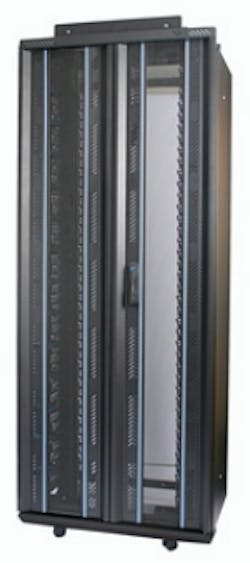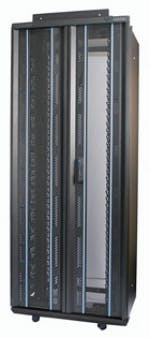In data centers, don’t use the patch of the day
From the September, 2012 Issue of Cabling Installation & Maintenance Magazine
Examining the evolution of the patching frame and what to look for when selecting this important infrastructure component.
By Matt Goulding, Cannon Technologies
The modern data center is a highly complex entity and a failure to specify the correct type of containment solution can have serious consequences for temperature control, while compromising the security of active equipment. While the days of the patching frame being a simple passive product are long gone, a surprising number of data centers are still being configured using a number of different types of products from various manufacturers, which apart from looking disjointed has potentially serious implications for equipment cooling and security.
Trend setting
Although cabinets are a mainstay of the data center infrastructure, when it comes to patching the preferred option is to use purpose-built frames. Ease of access and enhanced cabling density are just two of the reasons why patching frames have become so popular, however most currently available patching frames have two serious downsides—a lack of security and no access control.
Fortunately, some forward-thinking manufacturers are dealing with this issue by creating products that feature tamper-proof side panels and lockable but removable doors. While this level of enhanced physical security should be welcomed, compliance with data-protection and corporate-accountability based legislation, such as Sarbanes Oxley, BASEL II and PCI, requires auditable records of physical and electronic access.
Acting up
This means that active security is essential and no longer is the passive key-operated cabinet lock adequate. Instead software controlled locks with PIN codes, radio frequency identification (RFID) cards and fingerprint/iris/retina scan biometrics are being used. This not only controls who can access the cabinet but also when and for how long, raising alarms if there is an unauthorized attempt to gain access or if the cabinet remains open beyond a technician’s allocated time slot.
The lock system can also be configured to provide even higher security features, i.e. to require two people—for instance, a technician and a security operative—to go through an authentication process before the cabinet will unlock. When in, CCTV cameras can be triggered to record the access session or a simple photograph taken of the person involved. With all such systems a full audit trail, including the video footage if taken, is stored for future reference.
In fact, any security and access control technology usually deployed in server racks can also be used in patching frames and use the same management control system. That is, of course, if the patching frame is from the same stable as the server cabinets. If they are not there’s a good chance that special metalwork will be necessary to plug air leaks, which is often a highly unsatisfactory solution.
Cool it down
The need to squeeze the maximum processing and storage into the smallest space has led to a massive increase in the heat density of the electronic equipment and in most data centers effective temperature control is essential.
One way this has been addressed is to avoid installing cabling under a false floor as it impedes the cold airflow, reduces cooling efficiency and affects power usage effectiveness (PUE). Rack-mounted cable tray systems provide the most convenient, cost-effective overhead cabling containment solution. The cables then flow into the top of the server cabinets and patching frames.
Suite talk
Although well designed for internal cable management, frames from structured cabling manufacturers tend not to “suite” well with the server cabinets and this inconsistent approach can play havoc with even the best cooling system.
This is especially evident with the “cocooning” approach that provides a system of overhead aisle panels and aisle end doors that effectively seal off the cold aisle. This ensures that the cold air emitted from the floor is sealed in a cocoon and is therefore unaffected by hot exhaust air and the cooling air can only exit through the equipment for which it is intended.
Although it is normal to keep patching separate from the cooled racks where possible, occasionally in-row patching is needed and here, using non-family patching frames or cabinets and server racks can inhibit the performance, with gaps allowing cold air to short-circuit the servers. This can be avoided by using the same family of frames, cabinets and raceways so that none of them interfere with the cold-aisle cocooning system.
Under new management
With more cable in the frame, the ability to carry out moves, adds and changes (MACs) quickly and easily becomes more of a challenge. Good cable management is therefore essential and it is wise to consider this when selecting a frame. Features such as vertical plastic covered steel cable rings on both sides of the frame and horizontal “fingers” at every U keep everything much neater and allow high-density patch panels to be fitted without compromising space with the use of horizontal cable manager panels.
The general preference among installers and consultants is for 800-mm-wide frames. However, when the frames are especially high—in the region of 47U—the sheer volume of vertical cables on either side means that 100-mm add-ons are required in order to double the cable capacity and provide effective cable management.
A 47-U-high patching frame that is full of Category 6A or Category 7 cables will also be incredibly heavy and will need to be properly secured. For safety reasons and in order to stop them tipping, the majority of consultants are now specifying that they be bolted to the building structure rather than just the raised floor tiles.
A consistent approach to cabinet and frame installation can assist with this by using raised access floor technology (RAFt) which replaces whole floor tiles with a raft-like structure bolted to the pedestals to which the cabinets and patching frame are all firmly bolted. This approach also avoids any need for cut floor tiles and is much better for air leakage control.
Looking good
Modern data centers are not just used to house technology; they have to look good. A “mix-and-match” approach to patching frames and cabinets will simply not suffice.
Also, while containment solutions have traditionally been supplied in black, black or black, we recently carried out some research that discovered the use of “gray-white” cabinets, racks and frames was found by many respondents to reduce the cost of their lighting by almost 30 percent, as rather than absorbing the light it reflects it back. It was also found to improve light levels in the workspace, leading to reduction in errors.
Specifying a patching frame that has been well designed with features and benefits that enhance security and cable management, ensure efficient cooling and enhance aesthetic appeal will reap its own rewards.::
Matt Goulding is managing director of Cannon Technologies (cannontech.co.uk).

